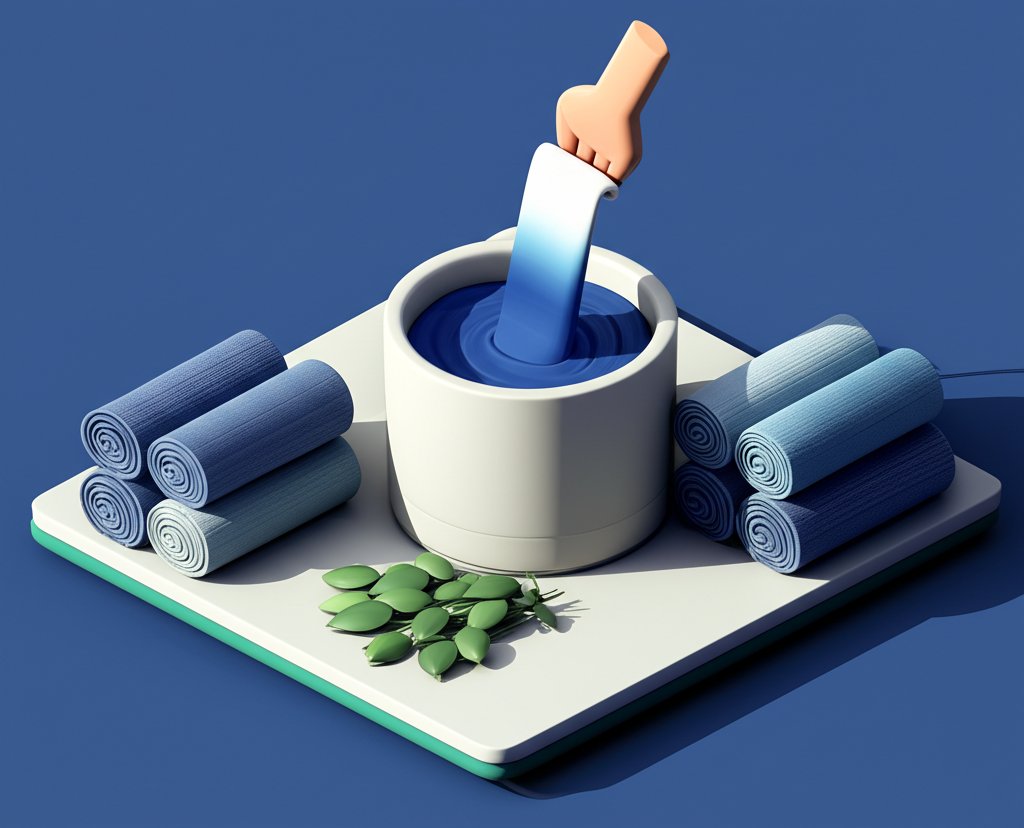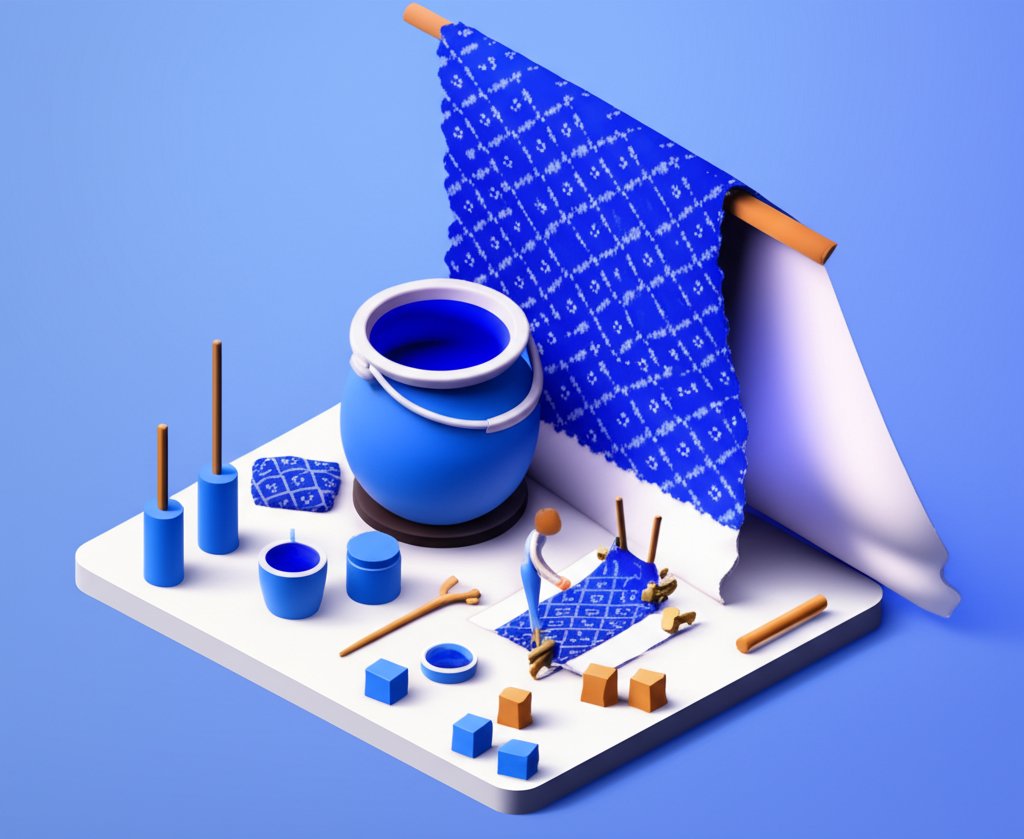Step into a world where ancient tradition meets modern creativity, where a single color can tell stories spanning millennia. We’re talking about indigo dye, a hue so profound it has captivated civilizations for centuries. While most associate its rich blue with their favorite pair of jeans, the true spectrum of indigo dye uses extends far beyond denim, unfolding into a vibrant narrative of natural dye applications, intricate dyeing techniques, and breathtaking textile art.
This article will plunge into the mesmerizing depths of indigo, uncovering its unparalleled versatility. Whether you’re a curious crafter, a sustainable fashion advocate, or an aspiring textile artist, prepare to be inspired by the boundless potential of this enigmatic blue. We’ll explore everything from its historical roots and scientific wonders to hands-on techniques and surprising applications, equipping you to master indigo and unleash your creative vision.
The Timeless Allure of Indigo Dye: A Historical & Scientific Overview

The journey of indigo is as rich and complex as its color. Understanding its essence is key to appreciating its diverse applications.
What is Indigo? Unpacking the Blue Pigment
At its heart, indigo dye is a vat dye, meaning it’s insoluble in water until chemically reduced to a soluble, yellowish form called leuco-indigo. Upon exposure to air (oxidation), it reverts to its brilliant blue, insoluble state, bonding permanently with fibers.
Historically, indigo dye was sourced exclusively as a natural dye from various plants, most notably:
Today, while natural indigo enjoys a resurgence thanks to eco-conscious movements, most industrial indigo dye is synthetically produced. This synthetic version, chemically identical to its natural counterpart, revolutionized textile manufacturing but often lacks the subtle nuances and environmental benefits of plant-derived pigment.
A Legacy in Blue: The Global History of Indigo Dye Uses
The story of indigo is woven into the fabric of human history. Evidence of indigo dye uses dates back over 6,000 years, with some of the earliest remnants found in Peru, dyeing cotton fabrics.
- Ancient Civilizations: From the burial cloths of ancient Egypt to the vibrant textiles of the Indus Valley Civilization (Harappa), indigo was a treasured commodity. Its deep, lightfast blue was a symbol of wealth, royalty, and spiritual significance across Asia, Africa, and the Mediterranean.
- Global Trade: Indigo became a critical item on ancient trade routes, including the Silk Road, linking distant cultures. Its value fueled economies and even sparked colonial rivalries, driving the cultivation of indigo plantations in the Americas and India. Guatemala, for instance, was a major global provider of indigo by the late 18th century.
- Cultural Significance: Beyond commerce, indigo found unique cultural expressions. The Tuareg people of the Sahara, known as “the Blue People,” dye their turbans with indigo, which transfers to their skin over time. Even modern uniforms, like the original postal worker attire, utilized indigo for its durable colorfastness. This deep connection to history makes indigo
a powerful medium for textile art.
Traditional & Modern Dyeing Techniques with Indigo
Mastering indigo dye is an art form that blends science with intuition. The magic truly happens in the vat, where reduction and oxidation transform fibers into captivating blue canvases.
Preparing Your Fabric: Scouring and Mordanting
For successful natural dye results, proper fabric preparation is paramount.
- Scouring: This is the deep cleaning of natural fibers (cotton, linen, silk, wool) to remove oils, waxes, and impurities that could impede dye absorption. A simple simmer with a mild detergent or soda ash usually suffices.
- Mordanting (or its absence for indigo): Unlike many other natural dye pigments that require a mordant (a metallic salt like alum) to fix the color, indigo is a substantive dye. It bonds directly with fibers through oxidation, meaning no mordant is typically required, simplifying the process for beginners and making it an attractive choice for sustainable textile art.
The Indigo Vat: From Creation to Immersion
The heart of indigo dyeing is the vat. Creating and maintaining a healthy vat is crucial for consistent results.
- Natural Fermentation Vats: These are the most traditional and eco-friendly. They rely on bacteria to create an alkaline, oxygen-free environment for reduction. Common recipes include:
- Fructose Vat: Uses fruit sugar (e.g., fruit pectin, dates) and lime (calcium hydroxide) as reducing agents.
- Iron Vat (Sakura Vat): Employs iron sulfate and lime, producing a slightly different blue often seen in historical methods.
- Urine Vat: An ancient, potent method, though less common today due to practicalities.
- Synthetic Reduction: For modern dyers, synthetic reducing agents like sodium hydrosulfite or thiourea dioxide provide faster, more predictable results, albeit with a less “natural” process.
The Dyeing Process: A Step-by-Step Guide
- Prepare the Vat: Follow your chosen recipe to create a reduced indigo vat. The liquid should be yellowish-green with a coppery “flower” on the surface, indicating it’s ready.
- Wet Your Fabric: Thoroughly wet your scoured fabric. This ensures even dye absorption.
- Submerge: Gently immerse the fabric into the vat, ensuring it’s fully covered and free of air bubbles. Avoid disturbing the “flower” on the surface too much.
- Hold: Keep the fabric submerged for 3-10 minutes, depending on desired depth of color.
- Lift and Oxidize: Slowly lift the fabric from the vat. As it meets the air, watch the magical transformation from green to brilliant blue. This is the oxidation process.
- Repeat: For deeper shades, allow the fabric to fully oxidize (20-30 minutes) and then re-dip. Repeat this process until the desired depth of blue is achieved.
- Rinse and Wash: Once satisfied, rinse the fabric thoroughly in cold water until the water runs clear. Follow with a gentle wash using a pH-neutral soap to remove any excess dye or reducing agents.
Resist Dyeing Techniques for Textile Art
Indigo excels in resist dyeing, where parts of the fabric are protected from the dye, creating stunning patterns. These dyeing techniques turn fabric into true textile art.
- Shibori: A Japanese resist dyeing method that includes a myriad of techniques:
- Itajime Shibori: Folding and clamping fabric between wooden blocks.
- Arashi Shibori: Wrapping fabric around a pole and compressing it.
- Nui Shibori: Stitching and gathering fabric tightly.
- Kumo Shibori: Pleating and binding sections.
- Kanoko Shibori: Tying small sections, similar to Western tie-dye.
- Batik: Originating in Indonesia, this technique uses molten wax as a resist. Designs are drawn or stamped onto fabric with wax, which is later removed after dyeing, revealing intricate patterns.
- Paste Resist: A blend of a thickener (like rice flour or soy milk protein) and lime applied to fabric to block the dye, often used in intricate Japanese katazome stenciling.
- Tie-Dye: A broader term encompassing techniques where fabric is tied, twisted, or folded before dyeing, creating concentric circles, swirls, and abstract designs.
Other Dyeing Techniques: Block Printing and Painting with Indigo Paste
Beyond full immersion, indigo can also be used for surface application.
- Block Printing: A reduced indigo paste can be applied to carved wooden blocks, then stamped onto fabric, creating repeated patterns. This offers precision and detail not always achievable with resist methods.
- Painting/Drawing with Indigo: Using thickened indigo paste, artists can directly paint or draw onto fabric, allowing for painterly effects and fine lines in their textile art.
Exploring Primary Indigo Dye Uses in Textiles
The most celebrated indigo dye uses are found in the textile world, where its robust color transforms everyday items into enduring classics and artistic statements.
Denim: The Unrivaled Icon
It’s impossible to discuss indigo dye without acknowledging its most famous application: denim. The classic blue of jeans is synonymous with indigo, and for good reason.
- How it Works: Cotton yarns are repeatedly dipped into indigo vats, but the dye only coats the surface of the fibers, rather than penetrating to the core. This “ring-dyeing” effect is what allows denim to develop its characteristic fading patterns over time, a beloved feature that adds character to each garment.
- Global Staple: From workwear to high fashion, blue jeans have transcended cultural and economic barriers, becoming a universal wardrobe staple and a testament to the durability and aesthetic appeal of indigo dye.
Beyond Denim: Wool, Silk, and Other Fibers
While cotton is the king of indigo dyeing, its versatility extends to other natural fibers, each offering a unique interaction with the natural dye.
- Wool: Protein fibers like wool absorb indigo beautifully, creating rich, deep blues. The fibers’ natural texture can lend a softer, more muted appearance compared to cotton. It’s crucial to maintain a moderate temperature in the vat for wool to prevent felting.
- Silk: Known for its luxurious sheen, silk takes indigo with elegance. The resulting blues are often luminous and vibrant. Like wool, silk requires careful handling in the vat.
- Linen and Hemp: These bast fibers accept indigo readily, producing strong, crisp blues perfect for rustic or utilitarian textile art projects.
- Blends: Natural fiber blends can also be successfully dyed, yielding interesting multi-tonal effects depending on the fiber composition.
These applications allow for a broad range of garments, from elegant scarves and dresses to durable outerwear and accessories.
Home Decor and Furnishings: Bringing Blue Indoors
The calming yet vibrant essence of indigo makes it a perfect choice for infusing homes with character and warmth. Its natural dye quality also adds an organic touch.
- Textile Art for the Home: Imagine throws draped over sofas, an array of shibori-dyed cushion covers, or exquisite indigo-dyed wall hangings transforming a living space.
- Functional Decor: Curtains, tablecloths, placemats, and even lampshades can be imbued with indigo’s charm, creating a cohesive and artful interior. The ability to create custom patterns using various dyeing techniques means unique pieces perfectly tailored to any home aesthetic.
- Sustainable Styling: Using natural dye for home textiles aligns with a sustainable lifestyle, offering an alternative to synthetic dyes found in mass-produced items.
Indigo in Textile Art and Creative Expression
Indigo is more than just a color; it’s a medium for profound artistic expression. Its rich history and adaptable nature make it a favorite among textile art practitioners.
Crafting Unique Apparel and Accessories
For many, indigo dyeing is a personal journey of transforming simple fabrics into wearable art.
- Personalized Garments: From plain t-shirts and denim jackets to bespoke dresses, indigo offers endless possibilities for customizing clothing. Hand-dyed pieces carry a unique story and character that mass-produced items lack.
- Accessories: Scarves, tote bags, hats, and even jewelry components can be dyed with indigo, creating one-of-a-kind statement pieces that reflect individual style. The interplay of various dyeing techniques on these smaller items can be particularly striking.
Fine Textile Art and Installations
Beyond practical uses, indigo holds a revered place in fine textile art. Artists worldwide utilize its depth and versatility to create museum-worthy works.
- Wall Hangings and Tapestries: Large-scale indigo-dyed pieces can serve as focal points in galleries and homes, showcasing intricate patterns achieved through resist techniques or painterly applications.
- Sculptural Forms: The stiffness of certain fabrics after dyeing, combined with the structural possibilities of folding and forming, allows artists to create three-dimensional textile art with indigo.
- Contemporary Artists: A growing number of contemporary artists are exploring indigo, not just for its color, but for its historical context, sustainable attributes, and the meditative process of working with a live vat. Their work often pushes the boundaries of traditional dyeing techniques.
The Resurgence of Natural Dye in Sustainable Fashion
The modern emphasis on sustainability has brought natural dye back into the spotlight, with indigo leading the charge.
The resurgence of interest in natural dyes like indigo mirrors a broader trend of valuing handcrafted and sustainable approaches in textiles, much like the dedication and skill involved in the historical art of dressmaking detailed in this article about the history of dressmaking.
- Environmental Benefits: Plant-based indigo offers a less toxic alternative to many synthetic dyes, reducing chemical runoff in waterways and supporting biodiversity. The creation of a natural indigo vat is often a low-impact process.
- Ethical Considerations: Choosing natural indigo supports traditional artisan communities and fosters a connection to the raw materials. It aligns with the slow fashion movement, valuing craftsmanship and longevity over fast, disposable trends.
- Aesthetic Appeal: The subtle variations, living quality, and unique fading of natural indigo are deeply cherished by designers and consumers seeking authenticity and environmental responsibility in their textile art and fashion choices.
Unexpected Indigo Dye Uses: Beyond the Fabric
While its primary domain is textiles, indigo’s versatility has surprising ventures into other realms, showcasing its diverse properties historically and in niche modern applications.
Culinary Applications: A Pop of Blue in Food
Perhaps one of the most unexpected indigo dye uses is its edible form. Certain indigo-producing plants, like Strobilanthes cusia (often called “Assam Indigo” or “Blue Meghalaya”), have leaves that can be processed into an edible blue powder.
Visual Delights: This edible powder can be used as a natural food coloring, adding a captivating blue hue to:
- Sweets: Icing, cakes, macaroons, and candies.
- Drinks: Smoothies, lattes, or specialty cocktails.
- Savory Dishes: Rice, noodles, or even as a unique spice blend for an exotic touch.
Important Note: When considering edible indigo, it’s crucial to source it from reputable suppliers who can guarantee its food-grade safety and ensure it comes from the correct plant species. Not all indigo plants or dye preparations are suitable for consumption.
Hair Dye: Nature’s Blue for Your Tresses
For those seeking a natural dye for hair, indigo offers an intriguing alternative to chemical hair colorants.
- Achieving Blue Tones: Used on its own or over lightened hair, pure indigo powder can impart shades of blue, from subtle navy to vibrant azure, depending on the hair’s base color and the application process.
- Deepening Henna: Indigo is most commonly used in conjunction with henna. When applied after a henna treatment, indigo can transform henna’s red-orange tones into rich browns or even jet black. This two-step process is a popular natural dye method for achieving dark hair colors without harsh chemicals.
Medicinal and Protective Properties (Historical Context)
Historically, indigo was recognized for more than just its aesthetic appeal. Traditional medicine systems in various cultures attributed several beneficial properties to indigo-producing plants.
- Immune Support: Some traditional practices utilized indigo extracts to support immune function and combat common ailments like colds and flu.
- Antibacterial Properties: Research has explored the antibacterial properties of indigo, suggesting its potential to inhibit bacterial growth, making it valuable in wound care in ancient times.
- Other Protective Attributes: Beyond historical medicine, indigo has also been noted for acting as a nematicide (protecting against plant-parasitic nematodes) and even demonstrating flame-retardant properties in certain applications, highlighting its multifaceted nature. While these properties are intriguing, modern scientific validation and practical application for these uses are still areas of research and are not primary commercial indigo dye uses today.
Conclusion: Embracing the Blue Horizon of Indigo
From the ancient vats of Peru to the cutting-edge ateliers of modern textile art, the journey of indigo dye is a testament to its enduring power and versatility. We’ve delved into its fascinating history, demystified the science behind its captivating color, explored a myriad of dyeing techniques, and discovered its expansive indigo dye uses in textiles and beyond.
Indigo is more than just a pigment; it’s a living tradition, a sustainable choice, and an unparalleled medium for creative expression. Whether you’re drawn to its iconic presence in denim, its gentle touch as a natural dye for home decor, or its profound potential in textile art, the world of indigo invites you to explore, experiment, and make your own mark in brilliant blue. So, gather your materials, prepare your vat, and immerse yourself in the magic of indigo – the possibilities are as limitless as the sky.
FAQ

What are the primary uses of indigo dye?
Indigo dye is primarily used for dyeing natural fibers, most famously cotton to produce denim for jeans. It’s also widely used for dyeing wool, silk, linen, and hemp for a variety of garments, home decor items, and textile art projects.
Can indigo dye be used as a natural dye at home?
Yes, indigo dye is a popular natural dye for home crafters and artists. It can be prepared using natural fermentation vats (e.g., fructose, iron) and applied to various natural fibers using traditional dyeing techniques like immersion, shibori, and batik.
What are some popular dyeing techniques for indigo?
Popular dyeing techniques for indigo dye include immersion dyeing in a vat for solid colors, and various resist methods such as Shibori (tie-dye, folding, clamping, stitching), Batik (wax resist), and paste resist printing. These techniques are commonly used to create intricate patterns in textile art.
Is indigo safe for textile art on all fabrics?
Indigo dye works best on natural fibers like cotton, linen, hemp, silk, and wool. While it can be used on some blends, its color adhesion and vibrancy are most pronounced on 100% natural materials. It is generally safe for these textiles, producing a durable, lightfast color.
Are there non-textile indigo dye uses?
Yes, beyond textiles, indigo dye uses extend to niche applications. Certain food-grade indigo (from specific plant sources) can be used as a natural dye in culinary applications for coloring foods and drinks. It’s also used as a natural dye for hair, often in combination with henna, and historically, it possessed medicinal and protective properties.
What’s the difference between natural and synthetic indigo dye?
Natural dye indigo is extracted from indigo-producing plants (e.g., Indigofera tinctoria, woad) through a fermentation process. Synthetic indigo is chemically synthesized. While chemically identical, natural indigo often has subtle nuances in color, a more complex dyeing process, and is favored for its environmental benefits and connection to traditional textile art practices.










